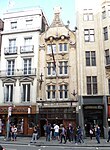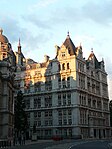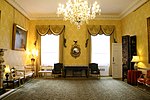Silver Cross Tavern
1674 establishments in EnglandBrothels in the United KingdomGrade II listed pubs in the City of WestminsterProstitution in EnglandUse British English from January 2014

The Silver Cross Tavern is a pub on Whitehall in London, England. It was first opened as a licensed pub in 1674. The building had been an establishment at that location since the thirteenth century. It has been argued to be the only theoretically legal (albeit non-operating) brothel in the country, on the grounds that a 17th-century royal licence on the building was never revoked.
Excerpt from the Wikipedia article Silver Cross Tavern (License: CC BY-SA 3.0, Authors, Images).Silver Cross Tavern
Whitehall, London Covent Garden
Geographical coordinates (GPS) Address Phone number Website Nearby Places Show on map
Geographical coordinates (GPS)
| Latitude | Longitude |
|---|---|
| N 51.506388888889 ° | E -0.12694444444444 ° |
Address
Grand Caffe Concerto
Whitehall 43
SW1A 2BX London, Covent Garden
England, United Kingdom
Open on Google Maps










